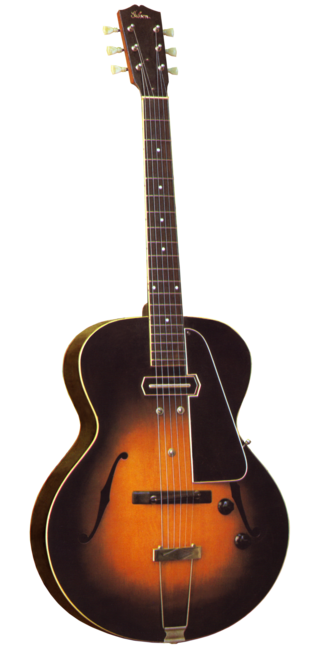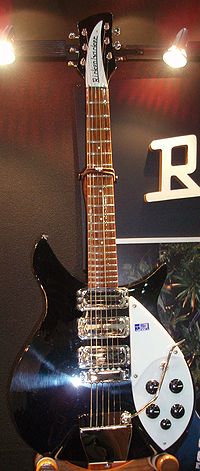
The bass guitar, electric bass or simply bass is the lowest-pitched member of the guitar family. It is a plucked string instrument similar in appearance and construction to an electric or acoustic guitar, but with a longer neck and scale length. The bass most commonly has four strings, though five- and six-stringed models are also relatively popular, and basses with even more strings or courses have been built. Since the mid-1950s, the bass guitar has largely come to replace the double bass in popular music due to its lighter weight, the inclusion of frets in most models, and, most importantly, its design for electric amplification.

An electric guitar is a guitar that requires external amplification in order to be heard at typical performance volumes, unlike a standard acoustic guitar. It uses one or more pickups to convert the vibration of its strings into electrical signals, which ultimately are reproduced as sound by loudspeakers. The sound is sometimes shaped or electronically altered to achieve different timbres or tonal qualities from that of an acoustic guitar via amplifier settings or knobs on the guitar. Often, this is done through the use of effects such as reverb, distortion and "overdrive"; the latter is considered to be a key element of electric blues guitar music and jazz, rock and heavy-metal guitar-playing. Designs also exist combining attributes of the electric and acoustic guitars: the semi-acoustic and acoustic-electric guitars.
Rickenbacker International Corporation is a string instrument manufacturer based in Santa Ana, California. The company is credited as the first known maker of electric guitars – a steel guitar in 1932 – and today produces a range of electric guitars and basses.

A semi-acoustic guitar, also known as a hollow-body electric guitar, is a type of electric guitar designed to be played with a guitar amplifier featuring a fully or partly hollow body and at least one electromagnetic pickup. First created in the 1930s, they became popular in jazz and blues, where they remain widely used, and the early period of rock & roll, though they were later largely supplanted by solid-body electric guitars in rock.

The Gibson ES-335 is a semi-hollow body semi-acoustic guitar introduced by the Gibson Guitar Corporation as part of its ES series in 1958. It features a solid maple wood block running through the center of its body with upper bouts that are hollow and two violin-style f-holes cut into the top over the hollow chambers. Since its release, Gibson has released numerous variations of and other models based on the design of the ES-335.

Karl Höfner GmbH & Co. KG is a German manufacturer of musical instruments, with one division that manufactures guitars and basses, and another that manufactures other string instruments, such as violins, violas, cellos, double basses and bows for stringed instruments.

The Gibson J-160E is one of the first acoustic-electric guitars produced by the Gibson Guitar Corporation.
A solid-body musical instrument is a string instrument such as a guitar, bass or violin built without its normal sound box and relying on an electromagnetic pickup system to directly detect the vibrations of the strings; these instruments are usually plugged into an instrument amplifier and loudspeaker to be heard. Solid-body instruments are preferred in situations where acoustic feedback may otherwise be a problem and are inherently both less expensive to build and more rugged than acoustic electric instruments.

The Epiphone Casino is a thinline hollow body electric guitar manufactured by Epiphone, a branch of Gibson. The guitar debuted in 1961 and has been associated with such guitarists as Howlin' Wolf, George Harrison, John Lennon, Paul McCartney, Noel Gallagher, Keith Richards, Dave Davies, Brad Whitford, Shirley Manson, Paul Weller, The Edge, Josh Homme, Daniel Kessler, Brendon Urie, Gary Clark, Jr., Glenn Frey, John Illsley, and Peter Green.

The Rickenbacker 330 is part of Rickenbacker's 300 series of guitars. The 330 entered the Rickenbacker product line in 1958, though at the time the 300 series of guitars was known as the "Capri" series. It was designed by the German luthier Roger Rossmeisl. The guitar is associated by many players with the jangle-rock sounds of bands from the 1960s and 1980s. The instrument incorporates many features standard on Rickenbacker guitars, including a three-ply maple/walnut neck, a shallow headstock angle, and a thick rosewood fretboard finished with clear conversion varnish. The 330 also features a body with Rickenbacker's "crescent moon" double-cutaway shape with sharp, unbound edges, and an R-shaped trapeze tailpiece. One idiosyncrasy of the guitar is its dual truss rods, which allow for the correction of problematic and unwanted twists, as well as curvature, of the guitar's neck. The 330 is equipped with a monaural jack plate, lacking the Rick-O-Sound stereo functionality of other Rickenbacker models such as the Rickenbacker 360.
The Danelectro Shorthorn line of guitars is a dual cutaway hollow bodied design, made of Masonite and poplar. The original models were introduced in 1959 to replace the U model guitars, and were in production until the closure of the Danelectro company in 1969.
Electric guitar design is a type of industrial design where the looks and efficiency of the shape as well as the acoustical aspects of the guitar are important factors. In the past many guitars have been designed with various odd shapes as well as very practical and convenient solutions to improve the usability of the object.
The Rickenbacker 300 series is a series of semi-acoustic guitars manufactured by the Rickenbacker Company. The series was launched in 1958, shortly after F.C Hall took over Rickenbacker. The guitars were created by Roger Rossmeisl, a German guitar maker.

The Rickenbacker 360/12 is the Rickenbacker company's 12-string variant of their 360 electric guitar model. Mainly known for producing "jangly" sounds, it was among the first electric 12-string guitars. The 360/12 was given worldwide attention when George Harrison used it on many Beatles recordings, introducing the distinctive new sound of this guitar on "I Call Your Name", which the band recorded in March 1964. In the late 1960s, the company made alternative models such as the Rickenbacker 370/12, which became the favored instrument of Roger McGuinn of the Byrds.
The Gibson ES series of semi-acoustic guitars are manufactured by the Gibson Guitar Corporation.

John Lennon's musical instruments were both diverse and many, and his worldwide fame resulted in his personal choices having a strong impact on cultural preferences.
The Rickenbacker 4001 is an electric bass that was manufactured by Rickenbacker as a two-pickup "deluxe" version of their first production bass, the single-pickup model 4000. This design, created by Roger Rossmeisl, was manufactured between 1961 and 1981, when it was replaced by an updated version dubbed the Rickenbacker 4003. Variant models of the 4001 include the 4001S, 4001LH, 1999, 4001V63 (reissue), 4001CS and the 4001C64 and 4001C64S: the C Series is a recreation of Paul McCartney's left-handed 4001S with a reversed headstock. There are also Al Cisneros and Lemmy Kilmister signature versions of the instrument.
The Höfner 500/1 Violin Bass is a model of electric bass manufactured by Höfner under several varieties. It was introduced in 1955 and gained celebrity status during the 1960s as the primary bass used by Paul McCartney of The Beatles.

The Rickenbacker 400-Series was a line of lower cost solid body electric guitars that Rickenbacker introduced in 1956.














